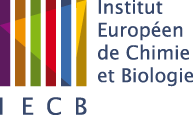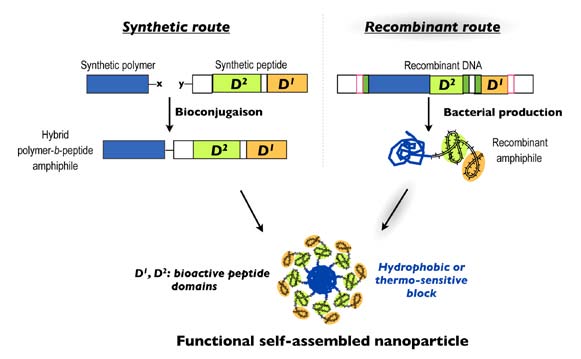| Peptide-based polymer assemblies |
|
Dr. Élisabeth GarangerUniversitĂ© Bordeaux - GIS AMA contract This e-mail address is being protected from spambots. You need JavaScript enabled to view it Tel: +33(0)540003035 Ă‚Â BioTrained as a chemist, Elisabeth Garanger graduated in 2001 as a Chemical Engineer from ENSC Clermont-Ferrand with a Master’s degree in Biological Organic Chemistry. She pursued her education with a PhD in chemistry and biology at the University of Grenoble. Under the supervision of Profs. P. Dumy and M.-C. Favrot, she dedicated her research to peptide-based vectors targeting tumors and their associated neo-angiogenesis. In 2006, she joined the Center for Molecular Imaging Research (Harvard Medical School, Boston) as a post-doctoral fellow and worked on contrast agents for multimodal molecular imaging. In 2009, she returned to France in the group of Prof. S. Lecommandoux (LCPO, Bordeaux) to contribute to a European project aiming at developing polymer-based nanoparticles for imaging and therapy of cancers. Elisabeth Garanger joined the IECB as team leader in October 2010. Ă‚Â Keywords / Expertise / Techniquesself-assembly, copolymers, peptide amphiphiles, functional nanomaterials, biomaterials, solid-phase peptide synthesis, bioconjugation chemistry, chemoselective ligations, self-assembled polymer nanoparticles, manual and automated SPPS, HPLC, SEC, MS-ESI and MALDI-TOF, DLS, DSC, TEM Ă‚Â SummaryThe goal of the Peptide-based Polymer Assemblies team is to design well-defined polymer materials featuring self-assembly and biological properties encoded at the molecular level in order to access biofunctional nanomaterials. To this aim, two parallel and complementary approaches are being considered. Amphiphilic hybrid materials featuring a synthetic polymer block conjugated to a peptide segment will be synthesized. After better understanding the structure and function of the peptide sequences, a recombinant approach will be used to rationally design monodisperse protein-like polymers. Recombinant DNA and protein engineering techniques will be used to produce recombinant polymers, mainly based on elastin-like motifs combined with biofunctional sequences. Self-assembly mechanisms will be studied and biological activities assessed with the ultimate goal of preparing new nanodevices for imaging and therapy. This project is developed in relation with the “Polymer Nanotechnology for Life Science” team of the LCPO (UMR 5629) led by S. Lecommandoux. Ă‚Ă‚Ă‚Ă‚Ă‚Â Activity reportThe design of functional self-assembled nanomaterials is currently a major challenge of nanotechnologies and concerns domains as broad as health, communication and information, and energy. In the specific field of biomimetic nanotechnologies, this goal is motivating multidisciplinary and translational research involving communities such as peptide, protein and nucleic acid specialists as well as polymer scientists. Indeed, synthetic block copolymers possess tremendous self-assembling propensities that have prompted their use for the preparation of self-assembled nano-objects. However, despite the huge number of chain lengths, sizes, architectures, and chemical characters available, most copolymers are devoid of biological information. This translates into a weak diversity of nano-materials obtained from solely synthetic copolymers as compared to highly complex and diverse natural self-assembled structures (e.g. proteins, ribosomes, molecular motors, viruses). Conversely, self-assembly of peptides and proteins, that are extraordinarily rich in terms of their secondary and tertiary structures and biological functions, is extremely difficult to control and to achieve by synthetic chemists. One of today’s consensuses thus relies on the association of natural structures with polymer blocks into a single molecule in order to integrate the advantages of both materials and overcome the limitations inherent to each one separately. In particular, by joining the self-assembly propensities of copolymers together with the richness of function-bearing peptides or protein domains, one may ultimately be able to reproduce what nature makes and controls perfectly and be able to access biomimetic nano-assemblies able of better interacting with biological structures. To this aim, different groups are focusing on the conjugation of functional peptides or proteins with synthetic polymer with defined self-assembly properties. In parallel, an extremely attractive and powerful approach for preparing such materials with dual self-assembly and bioactive properties consists in implementing methods from recombinant DNA and protein engineering technologies in order to have microorganisms to produce amphiphilic biofunctional recombinant materials. Ă‚Ă‚Ă‚Ă‚Ă‚Â
In this context, our group will focus on the design and synthesis of peptide-based polymer materials, featuring a hydrophobic or thermo-responsive polymer block, as the driving force for self-assembly, and a peptide segment providing bioactivity to the nano-assemblies. Two parallel approaches will be investigated to prepare either hybrid materials from traditional peptide synthetic routes or recombinant materials from protein-engineering techniques. Self-assembly mechanisms into bio-inspired, nanoscale, and bioactive objects will be studied using techniques from physico-chemistry to cellular biology. Ă‚Ă‚Ă‚Ă‚Ă‚Â Selected publications
Ă‚Ă‚Ă‚Ă‚Ă‚Â Research team
The team is part of the “Laboratoire de Chimie des Polymères Organiques” (LCPO), CNRS/Université Bordeaux 1/Polytechnique Institute of Bordeaux (IPB-ENSCBP), (UMR 5629) |
2, Rue Robert Escarpit - 33607 PESSAC - France
Tel. : +33 (5) 40 00 30 38 - Fax. : +33 (5) 40 00 30 68





